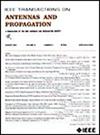A Circularly Polarized Omnidirectional Rydberg Atomic Sensor Using Characteristic Mode Analysis
IF 4.6
1区 计算机科学
Q1 ENGINEERING, ELECTRICAL & ELECTRONIC
引用次数: 0
Abstract
Rydberg atomic sensors (RASs) have garnered significant attention as a novel type of electric field sensor with high sensitivity. While the integration of electric field enhancement structure (EFES) and RASs has been proven to improve the sensitivity and the minimal detectable electric field of RAS, there are concerns regarding their omnidirectional and polarization performance. However, most existing RASs or RASs loaded with EFES operate with linear polarization, which reduces the sensitivity to circularly polarized (CP) microwave reception. It is a challenging method to change the property of the lasers to modify the RAS’s CP property, while it is simpler to use EFES to change RASs’ polarization indirectly. Meanwhile, current EFES research mainly focuses on the response of electric field enhancement at a fixed incident angle, limiting extension to 3-D CP patterns and lacking clear physical insights to guide. To address this, we propose an RAS with CP EFES to achieve CP reception capability. The EFES converts spatial CP electric field into local linearly polarized (LP) electric field, adjusting the RAS characteristics accordingly. We use characteristics mode (CM) methods, dividing the problem into modal current, governing the modal patterns, and external CP excitation sources, determining the coefficients of each modal pattern. This method reduces the complexity of the pattern analysis and improves the efficiency of optimization design. To validate the proposed method’s efficiency, we fabricate a prototype to measure reception pattern and further study the CP performance using an atomic heterodyne approach. The results indicate that the RAS with EFES achieves the right-hand CP (RHCP) omnidirectional reception capability, and the sensitivity is improved by 19.2 dB at 2.195 GHz. The cross-polarized level can be further improved to 24.5 dB using an atomic heterodyne approach.利用特征模式分析的圆极化全向雷德贝格原子传感器
里德伯原子传感器(RASs)作为一种新型的高灵敏度电场传感器受到了广泛的关注。虽然电场增强结构(EFES)与RAS的集成已经被证明可以提高RAS的灵敏度和最小可探测电场,但它们的全向和极化性能仍然存在问题。然而,现有的RASs或加载EFES的RASs大多采用线极化,这降低了对圆极化微波接收的灵敏度。通过改变激光器的特性来改变RAS的CP特性是一种具有挑战性的方法,而利用EFES间接改变RAS的偏振是一种更简单的方法。同时,目前的EFES研究主要集中在固定入射角下电场增强的响应,限制了对三维CP模式的扩展,缺乏清晰的物理认识来指导。为了解决这个问题,我们提出了一个带有CP EFES的RAS来实现CP接收能力。EFES将空间CP电场转换为局部线极化(LP)电场,并相应地调整RAS特性。我们使用特征模态(CM)方法,将问题分为模态电流,控制模态模式和外部CP激励源,确定每个模态模式的系数。该方法降低了模式分析的复杂性,提高了优化设计的效率。为了验证该方法的有效性,我们制作了一个原型来测量接收方向图,并使用原子外差方法进一步研究了CP性能。结果表明,采用EFES的RAS实现了右手CP (RHCP)全向接收能力,在2.195 GHz频段的灵敏度提高了19.2 dB。使用原子外差方法可以进一步将交叉极化电平提高到24.5 dB。
本文章由计算机程序翻译,如有差异,请以英文原文为准。
求助全文
约1分钟内获得全文
求助全文
来源期刊
CiteScore
10.40
自引率
28.10%
发文量
968
审稿时长
4.7 months
期刊介绍:
IEEE Transactions on Antennas and Propagation includes theoretical and experimental advances in antennas, including design and development, and in the propagation of electromagnetic waves, including scattering, diffraction, and interaction with continuous media; and applications pertaining to antennas and propagation, such as remote sensing, applied optics, and millimeter and submillimeter wave techniques

 求助内容:
求助内容: 应助结果提醒方式:
应助结果提醒方式:


